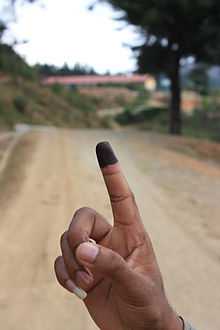Election ink


| Part of the Politics series |
|
| Politics portal |
Electoral ink, electoral stain or phosphoric ink is a semi-permanent ink or dye that is applied to the forefinger (usually) of voters during elections in order to prevent electoral fraud such as double voting. It is an effective method for countries where identification documents for citizens are not always standardised or institutionalised.
Application
Electoral stain is used as a good security feature to prevent double voting in elections. Ink is normally applied to the left hand index finger, especially to the cuticle where it is almost impossible to remove quickly. Ink may be applied in a variety of ways, depending on circumstance and preference. The most common methods are via dipping bottles with sponge inserts, bottles with a brush applicators, spray bottles, and marker pens. With all methods the finger should be left to dry for 15–30 seconds and exposed to light before being cleaned to ensure the mark remains visible for the desired length of time.
Composition
Electoral stain typically contains a pigment for instant recognition, and silver nitrate which stains the skin on exposure to ultraviolet light, leaving a mark that is impossible to wash off and is only removed as external skin cells are replaced. Industry standard electoral inks contain 10%, 14% or 18% silver nitrate solution, depending on the length of time the mark is required to be visible. Although normally water-based, electoral stains occasionally contain a solvent such as alcohol to allow for faster drying, especially when used with dipping bottles, which may also contain a biocide to ensure bacteria aren't transferred from voter to voter.
Longevity
Election stain typically stays on skin for 72–96 hours, lasting 2 to 4 weeks on the fingernail and cuticle area. The election ink used in India puts a permanent mark on the cuticle area which disappears only with the growth of new nail. It can take up to 4 months for the stain to be replaced completely by new nail growth. Stain with concentrations of silver nitrate higher than 18% have been found to have no effect on stain longevity, as even with stronger solutions silver nitrate doesn't have a photosensitive reaction on live skin cells. This means that the stain will wear off as new skin grows.[1] Silver nitrate is an irritant and frequently harmful at 25% solution and above, even being used as an effective, if painful, cauterizing agent in the treatment of rhinitis at that concentration.[2] At 25% the silver nitrate content will also start to precipitate depending on conditions, forming fine crystals which can also be irritating on skin and reducing the active dissolved silver nitrate back to as low as 18%.
Colour
Electoral stain is traditionally violet in colour, before the photosensitive element takes effect to leave a black or brown mark. However for the Surinamese legislative election, 2005, orange replaced violet as the colour for marking the voters' fingers as it was found to last just as long and be more appealing to voters, as it resembled the national colours. In some parts of the world, women stain their fingers violet for cosmetic reasons, meaning a different colour would be needed in such places to distinguish the marks and to ensure nobody was unfairly prevented from voting.
Efficiency
Marker pens are the most efficient use of ink, with one 5ml pen able to mark 600 people, although dipping bottles are often preferred, despite a 100 ml bottle only marking 1000. This may be due to the iconic images associated with the Iraqi and Afghan elections of the early 21st century. Dipping bottles can leave a more comprehensive stain of slightly longer longevity (depending on silver nitrate content) than markers can. However marker pens are much cheaper and easier to transport, reducing costs to the election organisers considerably, and the advised option when stains are only needed to be guaranteed for 3 to 5 days. Marker pens also leave a much smaller mark when properly applied, which is more agreeable to many voters.
Controversies
In the Afghan presidential election, 2004, allegations of electoral fraud arose around the use of indelible ink stains, which many claimed were easily washed off.[3] Election officials had chosen to use the more efficient marker pen option; however, regular marker pens were also sent out to polling stations, which led to confusion and some people being marked with less permanent ink.[4]
Critics of indelible ink point out that an individual can theoretically circumvent the security of indelible ink by coating the finger with a temporary yet transparent glue. The indelible ink would adhere to the glue which could then be washed off leaving the individual available for another round of voting. Sabotaging the finger marking process could cast doubt on the legitimacy of the vote.
In the Malaysian general election, 2008, the election authorities canceled the use of Electoral Stain a week before voters went to the polls,[5] saying it would be unconstitutional to prevent people from voting even if they had already had their fingers stained. Additionally they cited reports of ink being smuggled in from neighboring Thailand[6] in order to mark peoples' fingers before they had a chance to vote, thus denying them their rights.
During the Zimbabwean presidential election, 2008, reports surfaced that those who had chosen not to vote were attacked and beaten by government sponsored mobs. The mobs attacked those without ink on their finger.[7]
During the 2010 Afghan elections the Taliban delivered night letters threatening to cut off anybody's finger who was marked with indelible ink. [8]
During the Malaysian general election, 2013, in light of the first ever implementation of Electoral Stain, voters reported that the ink could be easily washed off with running water, despite assurances by the Election Commission of Malaysia on the contrary.[9]
International use
Some countries which have used Electoral stain in general elections include:
- Afghanistan
- Algeria
- Bangladesh
- Benin
- Burkina Faso
- Canada
- Democratic Republic of the Congo
- Dominica
- Egypt
- Gambia
- Honduras
- India
- Indonesia
- Iraq
- Islamic Republic of Pakistan
- Japan
- Jordan
- Kenya
- Lebanon
- Libya
- Malaysia
- Maldives
- Mauritania
- Mexico
- Mozambique
- Nepal
- Nicaragua
- Peru
- Philippines
- Saint Kitts and Nevis[10]
- Serbia
- South Africa
- Sri Lanka
- Suriname
- Syria
- Tchad
- Trinidad and Tobago
- Tunisia
- Turkey
- Uganda
- USA
- Venezuela
- Zimbabwe
References
- ↑ "''Chemical Safety Database''". Ptcl.chem.ox.ac.uk. Retrieved 2014-04-30.
- ↑ "''PakMediNet''". Pakmedinet.com. Retrieved 2014-04-30.
- ↑ Scott Baldauf. "''An Afghan 'Hanging chad' Dispute''". Csmonitor.com. Retrieved 2014-04-30.
- ↑ Raman, Sunil (2004-10-12). "''India link to Afghan ink stink''". BBC News. Retrieved 2014-04-30.
- ↑ "''MSN News article''". News.my.msn.com. Retrieved 2014-04-30.
- ↑ Wong, Raphael (2008-03-05). "''Ink Washout - The Star''". Thestar.com.my. Retrieved 2014-04-30.
- ↑ "World | Africa | Tsvangirai rejects 'sham' ballot". BBC News. 2008-06-27. Retrieved 2014-04-30.
- ↑ Eltaf Najafizada and James Rupert (20 October 2010). "New Candidates May Win Half of Afghan Parliament Seats Amid Ballot Fraud". Bloomberg.
- ↑ "Election ink under scrutiny in Malaysia - Asia-Pacific". Al Jazeera English. Retrieved 2014-04-30.
- ↑ http://www.oas.org/sap/docs/DECO/2010/SAINT_KITTS_NEVIS_JAN_25_2010.pdf
External links
| Wikimedia Commons has media related to Election ink. |